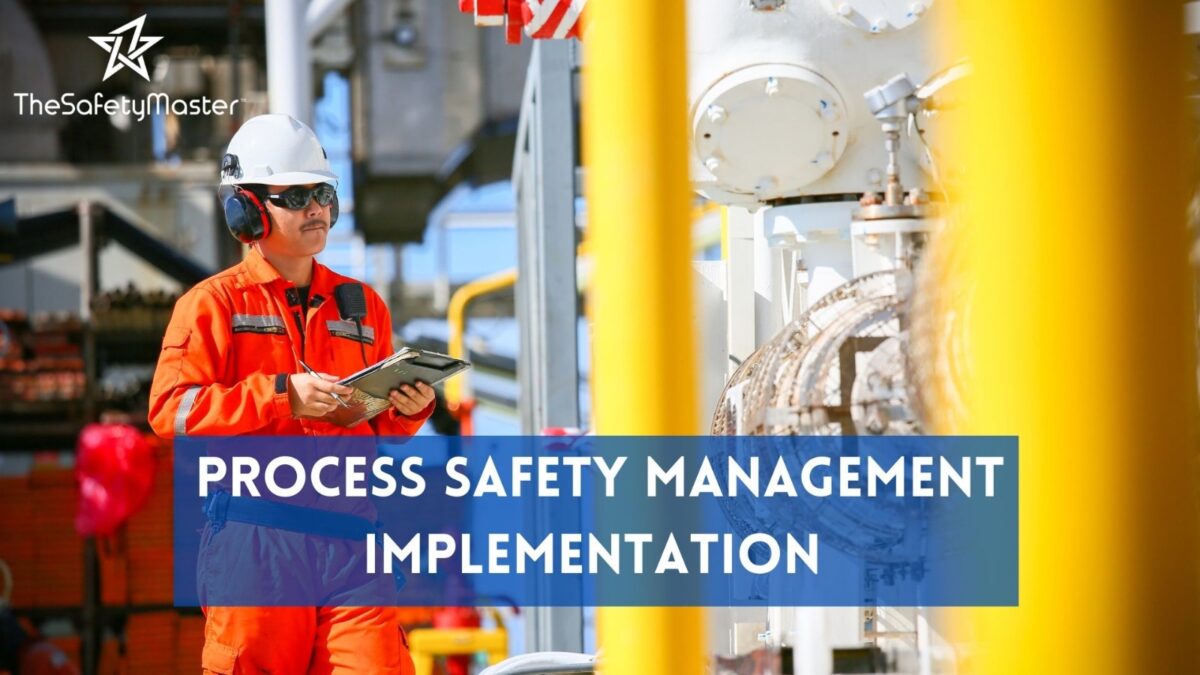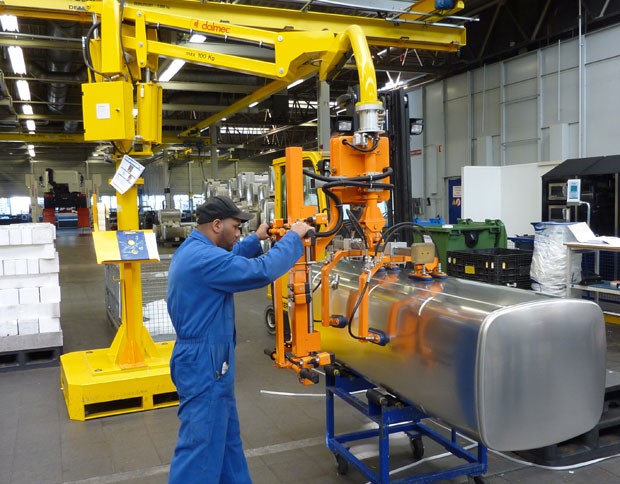Building a Strong Foundation – Steps to Establishing a Robust Process Safety Management System

Why Behaviour-Based Safety Implementation is a Game – Changer for Ensuring Employee Well-being and Productivity
January 29, 2024
Emergency Response and Containing of Ammonia Gas Leak
February 9, 2024In this article, we delve into the vital topic of building a strong foundation for a robust Process Safety Management (PSM) system. With safety being the utmost priority for any organization, establishing an effective PSM system is paramount. We will outline the essential steps required to achieve this, providing you with practical guidance and actionable insights. By the end of this article, you will have a comprehensive understanding of how to establish a robust PSM system that safeguards your organization, enhances productivity, and ensures compliance with regulatory standards. Let’s embark on this journey towards a safer and more successful future.
Introduction
Building a Strong Foundation: Steps to Establishing a Robust Process Safety Management System. In today’s fast-paced industrial landscape, ensuring the safety and well-being of employees, as well as safeguarding the environment, is paramount. A robust and comprehensive Process Safety Management (PSM) system is essential for organizations operating in high-risk industries such as oil and gas, chemicals, and manufacturing. However, establishing an effective PSM system can be a daunting task without proper guidance
Understanding Process Safety Management
Within the intricate realm of industrial operations, understanding process safety management is paramount to ensuring the well-being of both workers and the environment. This multifaceted concept encompasses a systematic approach that identifies, evaluates, and controls potential hazards associated with various processes. By comprehending process safety management, organizations can foster a culture that prioritizes safety, ultimately leading to enhanced productivity and peace of mind. At its core, process safety management involves a holistic view of risk management within an industrial setting. It moves beyond traditional occupational health and safety measures by focusing on preventing catastrophic incidents such as explosions or toxic releases. By recognizing the interplay between equipment, procedures, personnel, and their environment, companies can proactively mitigate potential hazards.
Understanding process safety management also necessitates acknowledging the importance of incorporating robust systems and technologies. Advanced instrumentation for real-time monitoring, intelligent alarms for early warning detection, and automated shutdown mechanisms serve as vital components in safeguarding operations against unforeseen accidents. Embracing these technological advancements not only enhances overall safety measures but also promotes efficiency and reliability in day-to-day operations. By embracing this comprehensive understanding of process safety management principles, organizations can foster a workplace culture rooted in resilience and continual improvement. Through a proactive approach to risk mitigation alongside the integration of cutting-edge technologies, industries have the power to create safer environments for their employees while simultaneously boosting productivity and elevating public confidence in their operations.
Importance of a Robust Process Safety Management System
Importance of a Robust Process Safety Management System formidable and well-established Process Safety Management (PSM) system is essential for the seamless operation of any industrial facility. Without it, the consequences can be dire, ranging from catastrophic accidents to environmental disasters. The significance of a robust PSM system lies in its ability to identify, prevent, and mitigate potential hazards and risks associated with process industries.
A comprehensive PSM system enhances the safety culture within an organization by promoting proactive measures that prioritize employee well-being and environmental sustainability. By implementing stringent safety protocols, organizations foster trust among their workforce, ensuring that employees feel valued and protected while carrying out their duties. Furthermore, an efficient PSM system establishes an environment that encourages innovation and creativity, as it allows employees to focus on their tasks without the constant burden of safety concerns.
In today’s fast-paced world, where technological advancements are rapidly transforming industries, the need for a robust PSM system becomes even more critical. By keeping up with evolving standards and best practices, organizations can stay ahead of potential risks and maintain a competitive edge in their respective fields. A strong emphasis on process safety not only guarantees regulatory compliance but also attracts investors who prioritize sustainable business practices.
In conclusion, a robust Process Safety Management system is integral to achieving operational excellence while ensuring the well-being of both employees and the environment. By instilling a safety-first culture within organizations through effective implementation of PSM strategies, businesses can optimize productivity while embracing continuous improvement. Ultimately, investing in process safety leads to long-term success by safeguarding lives, protecting assets, and maintaining public trust.
Assessing the Current State of Process Safety Management
Assessing the Current State of Process Safety Management: As we embark on the journey of building a robust process safety management system, it is imperative to assess the current state of affairs. This critical step allows us to identify existing strengths and areas for improvement, forming the foundation upon which we will build our safety framework.
In this stage, we delve deep into the various elements that constitute process safety management. We meticulously examine organizational structures, policies, procedures, and employee engagement levels. By conducting comprehensive audits and evaluations, we gain a holistic understanding of the current state of process safety within our organization.
During this assessment, it is vital to foster an environment that encourages open communication and transparency. Employees must feel empowered to share their perspectives and experiences without fear of retribution. By encouraging active involvement from all levels of the organization, we can truly grasp the reality on the ground and make informed decisions moving forward.
Identifying potential gaps in training programs or outdated procedures should be met with enthusiasm as they present opportunities for growth. Embracing an optimistic mind-set during this assessment phase enables us to envision a future where accidents are minimized, workplace morale soars high, and productivity thrives under a strong process safety management system
Identifying and Evaluating Hazards
Identifying and Evaluating Hazards: In order to establish a robust process safety management system, it is crucial to meticulously identify and evaluate potential hazards within the operational environment. A diligent examination of the facility, equipment, and processes is necessary to uncover existing or potential risks that could compromise safety. This proactive approach ensures that all potential hazards are acknowledged and addressed before they escalate into accidents or incidents that could harm personnel or damage property.
During the hazard identification phase, it is essential to employ comprehensive techniques such as hazard and operability studies (HAZOP) or failure mode and effects analysis (FMEA). These methods enable a systematic evaluation of each step within the operation, identifying possible deviations from normal functioning and their associated risks. Additionally, engaging frontline workers who have first-hand knowledge of the processes can provide invaluable insights into hidden hazards that may not be immediately apparent on paper.
To foster an optimistic outlook while addressing hazards, organizations should promote a culture of open communication where employees feel empowered to report near misses or unsafe conditions without fear of repercussions. By emphasizing shared responsibility for safety, individuals become active participants in hazard identification efforts. Recognizing and appreciating their contributions can inspire a sense of pride and ownership in maintaining a safe working environment for all. Ultimately, by proactively identifying and evaluating hazards, organizations pave the way for a more secure future while reinforcing trust among their workforce
Establishing Safety Policies and Procedures
In order to build a robust process safety management system, it is paramount to establish comprehensive safety policies and procedures. These guidelines provide a framework for employees to follow, ensuring consistency and accountability throughout the organization. When crafting these policies, it is crucial to involve all stakeholders, from management to frontline workers, fostering a sense of ownership and commitment towards safety.
A well-crafted policy should clearly outline the expectations and responsibilities of each individual involved in the process. It should address potential hazards specific to the industry, outlining preventive measures that must be taken. By incorporating input from various departments and utilizing industry best practices, organizations can create policies that not only comply with regulatory requirements but also exceed them.
Furthermore, procedures should be developed in conjunction with the policies to provide step-by-step instructions on how to execute tasks safely. These procedures should emphasize risk identification and mitigation strategies while ensuring that employees have access to relevant safety data sheets and equipment manuals. By prioritizing clear communication channels and engaging employees in regular training sessions regarding these procedures, organizations can foster a culture of safety consciousness where everyone feels empowered to speak up about potential risks.
Remember: when it comes to establishing safety policies and procedures, attention to detail is key. A carefully crafted framework sets the stage for successful implementation while instilling confidence among employees that their well-being is a top priority within the organization.
Training and Competency Development
Training and Competency Development: In order to establish a robust process safety management system, training and competency development are essential components. Organizations must invest in comprehensive training programs that equip employees with the necessary knowledge and skills to handle potential hazards effectively.
Training should encompass various aspects such as understanding the principles of process safety, recognizing potential risks, emergency response procedures, and utilizing safety equipment. It should be tailored to each employee’s role within the organization, ensuring they possess the specific competencies required for their tasks.
Competency development goes beyond initial training and involves continuous learning and improvement. Organizations should foster a culture of lifelong learning, providing regular updates on industry best practices and technological advancements. This not only enhances employees’ competence but also instils a sense of confidence in their abilities to manage safety effectively.
By investing in comprehensive training programs and promoting ongoing competency development, organizations can empower their employees to take ownership of process safety management. This approach not only mitigates potential risks but also creates a positive work environment where individuals feel confident and motivated in contributing to the overall success of the organization’s safety goals.
Implementing Effective Risk Management Strategies
Implementing Effective Risk Management Strategies: In the intricate web of process safety management, the implementation of effective risk management strategies stands as a beacon of protection, guiding organizations towards a secure future. These strategies act as the guardian angels of industrial processes, identifying potential risks and swiftly mitigating them to ensure smooth operations. By embracing a proactive approach, companies can navigate the treacherous waters of uncertainty with confidence and resilience.
One key aspect of implementing risk management strategies is conducting thorough risk assessments at critical junctures. This involves carefully analysing each step in the process, identifying potential hazards, and quantifying their likelihood and consequences. By quantifying risks through advanced methodologies such as hazard analysis or fault tree analysis, organizations gain valuable insights to make informed decisions regarding preventive measures and risk reduction techniques.
Another crucial element is fostering a culture of safety consciousness throughout the organization. This entails promoting open communication channels where employees feel empowered to report near misses or potential risks without fear of reprisal. By encouraging active participation from all levels within the organization, individuals become stakeholders in creating a safer work environment where risks are acknowledged and addressed promptly.
Imbuing risk management strategies with an optimistic spirit ensures that organizations view challenges as opportunities for improvement rather than insurmountable obstacles. This mind-set fosters creativity and innovation in finding novel ways to minimize risks while maximizing productivity. Embracing emerging technologies like artificial intelligence or machine learning can enhance risk assessment capabilities and enable real-time monitoring for timely intervention.
Ultimately, implementing effective risk management strategies is not just about compliance; it is about nurturing a resilient organizational culture built on trust, collaboration, and continuous improvement
Maintenance and Inspection Programs
A pivotal aspect of establishing a robust Process Safety Management (PSM) system is the implementation of comprehensive maintenance and inspection programs. These programs ensure that equipment, machinery, and systems are regularly examined, serviced, and repaired to guarantee their optimal functioning. By diligently adhering to these programs, organizations can mitigate the risk of equipment failure or malfunction that may lead to hazardous incidents. Maintenance activities encompass a wide range of tasks, including routine checks, preventive maintenance, and corrective repairs. Regular inspections play an indispensable role in identifying potential issues before they escalate into major problems. Through thorough examination, technicians can detect worn-out components, leaks, or signs of deterioration that could compromise safety. By addressing these issues promptly and effectively, companies can safeguard their operations and protect both employees and the environment.
In addition to promoting safety, well-executed maintenance and inspection programs also yield long-term benefits for organizations. Regular upkeep enhances the overall reliability of equipment while extending its lifespan. This not only reduces costs associated with frequent replacements but also optimizes efficiency by minimizing downtime due to unexpected breakdowns. Ultimately, prioritizing maintenance and inspections demonstrates a commitment to excellence in safety management while fostering operational continuity—a win-win situation for all stakeholders involved.
Reacting to and Learning from Incidents:
When it comes to process safety management, incidents can occur despite our best efforts. However, the true measure of a robust system lies in how effectively we react and learn from these incidents. In the aftermath of an incident, it is crucial to establish a thorough investigation process that aims to uncover the root causes and contributing factors. This investigation should involve gathering comprehensive data, conducting interviews with personnel involved, and utilizing advanced analytical techniques. By carefully analysing incidents, organizations can gain valuable insights into their processes, procedures, and equipment. These insights pave the way for implementing preventive measures that enhance safety levels. It is important not to view incidents as failures but rather as opportunities for improvement. Encouraging an open reporting culture where employees feel empowered to share their experiences and lessons learned can contribute significantly to organizational growth.
Moreover, sharing lessons learned from incidents across the industry fosters collaboration and knowledge exchange among stakeholders. Establishing platforms for communication such as conferences or online forums enables professionals to discuss best practices and innovative approaches towards enhancing process safety management systems. Ultimately, this collective effort enhances overall safety standards in industries across the globe, ensuring a safer working environment for all involved.
Continuous Improvement and Monitoring
One of the cornerstones of a robust Process Safety Management (PSM) system is the commitment to continuous improvement and monitoring. It is not enough to establish safety protocols; they must be regularly reviewed, refined, and enhanced to adapt to changing circumstances. By embracing a culture of ongoing improvement, organizations can stay proactive in identifying potential risks and finding innovative ways to mitigate them.
Monitoring plays a crucial role in assessing the effectiveness of existing safety measures and identifying areas for improvement. Regular inspections, audits, and assessments help organizations identify any deviations from established standards or procedures. By closely monitoring key performance indicators (KPIs) related to process safety, such as incident rates or near misses, organizations can proactively identify trends or patterns that require attention.
Furthermore, continuous improvement fosters an environment where all employees feel empowered to suggest improvements and share their insights regarding process safety. Encouraging open communication channels between management and front-line workers creates opportunities for collaboration in finding better ways to enhance safety measures. This collective effort towards improvement not only strengthens the PSM system but also nurtures a positive work culture that prioritizes employee well-being.
In conclusion, embracing continuous improvement and monitoring within a Process Safety Management system is vital for ensuring its long-term effectiveness. By regularly evaluating existing protocols, incorporating new knowledge and technologies, maintaining open communication channels with employees at all levels, organizations can create a dynamic safety framework that adapts to evolving challenges while fostering employee engagement. This concerted effort towards ongoing enhancement ultimately leads to safer working environments that protect both personnel and assets.
Conclusion
In essence, establishing a robust process safety management system is not merely an endeavour of compliance, but a commitment to safeguarding the well-being of both employees and the environment. By diligently implementing the steps outlined in this article – from hazard identification and risk assessment to training and continuous improvement – organizations can pave the way towards operational excellence. Remember, strong foundations are built brick by brick, and with every layer of safety added, we fortify our processes and enhance their resilience against potential hazards. Embrace this journey with unwavering dedication and watch as your organization flourishes in a culture of safety and success.




